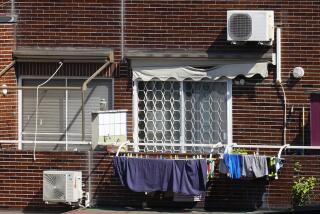THE SENSIBLE HOME : Solar Power Is Ideal Way to Beat Summer Heat
- Share via
QUESTION: Even with our air conditioner running, the sun still bakes us, especially in second-story rooms. Are there any methods to use the sun’s intense heat to help cool our house in the summer?
ANSWER: The same intense heat from the sun that bakes you can be used to cool your house for free. Solar power is an ideal fit with cooling because the greatest amount of solar energy is available during the hottest times.
There are new solar-powered devices that use the sun’s heat to cool and dehumidify your house. These bring in fresh dehumidified outdoor air. In the winter, the solar heat also can be used to heat your home for free.
Since the incoming fresh air is not humid, your air conditioner needs to run less. The drier air also allows you to set your thermostat a little higher and still be comfortable. This saves even more electricity.
One system, made by New Thermal Technologies, uses free heat from solar collectors to dry out (recharge) a slowly rotating desiccant wheel. A desiccant is a material that readily absorbs moisture. The only cost to run this unit is the electricity for a small motor and blowers.
As humid fresh outdoor air is drawn across the solar recharged desiccant, it is dehumidified before it enters your home. In some climates, a small amount of moisture is reintroduced into the air stream for evaporative cooling.
Stapling reinforced reflective foil under your roof rafters provides double solar cooling. First, foil blocks heat transfer from the hot roof to the ceiling below. In my own home, it lowered my bedroom temperature by 10 degrees.
Second, the solar heated air, between the roof and foil, naturally flows up and out roof vents. This draws cool air in the lower soffit overhang vents to cool the roof. It is important to install the roof vents near the peak. A continuous ridge vent is best.
If you use the least expensive single-sided foil (about 9 cents per square foot with a kraft paper backing), face the shiny side down. It will not be dulled by dust buildup over time.
Applying special heat-reflective attic paint on the underside of the roof reduces heat transfer downward. Just apply it from inside the attic to the sheathing.
The sun shining on a simple do-it-yourself wooden solar chimney creates a natural upward draft. Make the chimney extend from above the roof down to a room ceiling. Adding a clear window and insulation increases the draft.
Write for Update No. 717 listing manufacturers of solar-powered desiccant systems, reinforced attic foil, attic paint, ridge vents, specifications, prices and instructions for making a solar chimney. Please include $2 and a self-addressed envelope to James Dulley, Los Angeles Times, 6906 Royalgreen Drive, Cincinnati, Ohio 45244
Insulating Older, Double-Hung Window
Q: I have older double-hung windows in my house with counterbalance weights inside the frame. How can I insulate this cavity in the frame without interfering with the movement of the weights?
A: One effective method is to install 1 1/2-inch plastic pipe for the weights to slide in. Pull the trim loose from the frame to get access to the cavity. Cut the appropriate lengths of pipe. Drop the weights, with the ropes attached, into the pipes. Pack insulation around the pipes.
Another option is to remove the weights and pack the entire frame cavity with insulation. Install spring-type sash guides that will hold the window in any open position. Sash guide kits are available at many hardware stores.
Letters and questions to Dulley, a Cincinnati-based engineering consultant, may be sent to James Dulley, Los Angeles Times, 6906 Royalgreen Drive, Cincinnati, Ohio 45244.
More to Read
Inside the business of entertainment
The Wide Shot brings you news, analysis and insights on everything from streaming wars to production — and what it all means for the future.
You may occasionally receive promotional content from the Los Angeles Times.










